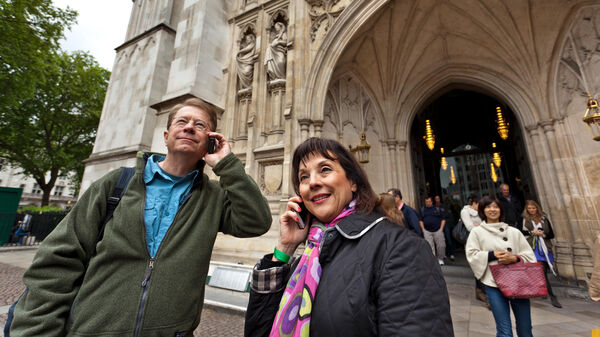Using a European SIM Card

By Rick Steves
While using your American phone in Europe is easy, it can get expensive. And unreliable Wi-Fi can make the reality of keeping in touch via a service like Skype or FaceTime more frustrating than it should be.
If you anticipate heavy phone or data use, consider traveling with a mobile phone equipped with a European SIM card. This gives you a European mobile number and access to cheaper rates than you'd get through your US carrier, even with an international plan.
To get a European SIM, you'll need to do the following:
1. Make sure you're equipped with a proper phone. You'll need either a European phone or an unlocked phone in order for a European SIM card to work (some phones are electronically "locked" so you can't switch SIM cards). Check with your carrier — it's possible the phone you have is already unlocked, as this feature is becoming more common in newer models. Otherwise, you can try asking your provider if they'll unlock it for you. Remember that as long as you have a European SIM in your own phone, you won't be reachable at your regular US number.
If it's not possible to unlock your phone, you can buy an unlocked phone either before your trip or at your destination (it's around $40 for a basic unlocked phone). It's also possible to buy an inexpensive mobile phone in Europe that already comes with a SIM card. If shopping for a phone in Europe, use the European term "mobile" (pronounce it the way Brits do — rhymes with "smile") or "handy" (common in German-speaking areas).
Finally, you may already have an old, unused mobile phone in a drawer somewhere. It's probably locked, but your provider may be willing to send you a code to unlock it.
2. Shop around for a SIM card. SIM cards are sold in Europe at department-store electronics counters, some newsstands, and even at vending machines. If you need help setting up your phone or determining the best option, buy your SIM card at a mobile-phone shop. Costing about $5–10, SIM cards usually include about that much prepaid calling credit, with no contract and no commitment. Expect to pay about $20–40 more for a SIM card with a gigabyte of data. Certain brands — including Lebara — are reliable and provide cheap international calls, including to the US.
Be aware that many smartphones (especially iPhones) use smaller micro-SIM or nano-SIM cards. Make sure you get the right size card for your phone.
Before buying a SIM card, ask the clerk about rates for calls within the country; to and from other countries you'll be visiting; and, if you plan on calling home, to the US and Canada. Also check the rates for data use and for sending/receiving a text message (called an "SMS" in Europe). Make sure you get rates for data and texting both within and outside the card's home country. Rates can vary wildly from brand to brand and store to store. European SIM cards do not charge for roaming in other EU countries (though in some cases, data caps are applied).
New phone models are increasingly using eSIMs rather than physical SIM cards. With these phones, you can add several SIM numbers to your device at once — without worrying about buying and installing a physical SIM card. This means that you can purchase and activate your international eSIM anywhere, anytime, without needing to visit a physical store. To find out if your phone is compatible with eSIMs, contact your provider.
3. Set up your SIM card. Once you buy your SIM card, ask the clerk to insert it, set it up, and make a test call to be sure it's working properly. Turning on the phone, you'll be prompted to enter the SIM PIN, which you may be asked to enter every time you start up the phone. If text or voice prompts are in another language, ask the clerk whether they can be switched to English. Also find out how to check your credit balance (usually you'll key in a few digits and hit "Send"). Remember to record your new phone number so you can pass it on to friends and family.
Note that many countries require you to register the SIM card with your passport as an antiterrorism measure. If that's the case, it may take an hour or two after submitting the information before you can use the phone.
4. Top up your SIM card. When you run out of credit, you can top it up at newsstands, tobacco shops, mobile-phone stores, or many other businesses (look for the SIM card's logo in the window). Tell the clerk how much credit you want. You'll either get a voucher with instructions (in most cases, to top up credit, you'll punch in a long string of numbers on your phone), or the clerk will send the credit directly to your phone. Some providers let you top up online.
Tips: Be aware that most European SIM cards expire after a certain period of inactivity (typically 3–12 months), so use up the credit or hand it off to another traveler. Also, be sure to save your contacts' phone numbers in the phone itself, rather than on the SIM card; otherwise, you'll lose access to them when you switch SIMs. When storing phone numbers, include the plus (+) sign and the country code to ensure that your calls will go through, regardless of where you're calling from.

